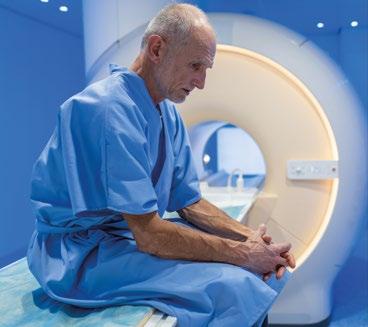
2 minute read
Endocrine therapy in advanced prostate cancer
from EYES Newsletter Winter 2021 /22 (The newsletter of the ESE Young Endocrinologists and Scientists)
Prostate cancer is the most diagnosed tumour pathology among men in more than 50% of countries worldwide and represents one of the leading causes of cancer-related death among the male population in developed countries. Importantly, when the cancer is diagnosed at an early stage, it usually represents a curable disease, due in part to the huge advances on surgery (radical prostatectomy) and radiotherapy during recent years. That is why it is so important for men to get themselves checked regularly! Unfortunately, these therapeutic strategies are not effective when we face advanced prostate cancers, clinically aggressive tumours that have spread to other sites of the body. In these cases, androgen deprivation therapy (ADT) as well as the blockade of the androgen receptor (AR) are the main standard-of-care therapeutic strategies.
But who discovered the anti-tumour effects of hormonal therapies in the context of prostate cancer? When? How? Let’s start at the very beginning…
Advertisement
In 1941, Charles Huggins (who was awarded the Nobel Prize in Physiology or Medicine in 1966) and Clarence Hodges demonstrated the beneficial effect of surgical castration for men with metastatic prostate cancer. The next revolution in the field arose in 1971, when Andrew Schally, Roger Guillemin, and Rosalyn Yalow (winners of the Nobel Prize in Physiology or Medicine in 1977) found that chronic administration of LHRH agonists led to pituitary gonadotropin inhibition, thus reducing secretion of LH and FSH and resulting in a significant decrease of circulating testosterone. In 1989, the FDA approved flutamide, the first nonsteroidal anti-androgen for the treatment of advanced prostate cancer, which binds to the AR, thus effectively inhibiting the actions of androgens. Despite promising anti-cancer activity, some clinical limitations of flutamide led to the development of secondgeneration anti-androgens (e.g., enzalutamide). Remarkably, after all these advances in the field, the current endocrine therapies for men with advanced prostate cancer still comprise LHRH agonists, second-generation anti-androgens and abiraterone. Specifically, abiraterone was developed in the early 1990s and consists of a potent inhibitor of CYP17, an enzyme that is involved in the synthesis of androgens, which is expressed in testicular, prostate, and adrenal tissue. Although, as mentioned before, endocrine therapy represents the main standard of care for patients with advanced prostate cancer nowadays, these tumours will eventually become resistant to this strategy, ultimately representing a lethal disease. The rapid development in understating of the prostate cancer biology and the latest scientific advances (e.g., next-generation sequencing, single cell analysis) were key to discovering numerous mechanisms of resistance to the endocrine therapies, including AR overexpression, AR mutations, AR splicing or increased AR ligand availability, opening new therapeutic avenues for this subset of patients that should be validated in clinical trials in the near future.
In conclusion, there is still a lot to be done to improve the outcome of patients with advanced prostate cancer, especially since the prevalence of this disease does not stop growing, but we are getting there, step by step.
Juan Manuel Jiménez Vacas,
UK










